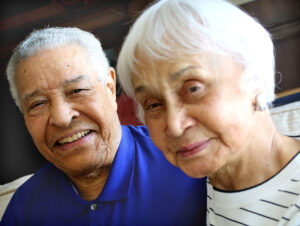LOCAL LEGACY: 33 YEARS OF SERVICE
SUNY Chancellor, Wife
Brought Experience,
Friends To Cooperstown
By JIM KEVLIN • Special to www.AllOTSEGO.com

COOPERSTOWN – If not for the Whartons, would Rosalynn Carter have ever looked across world-famous Otsego Lake toward the Sleeping Lion?
In 1978, when Clifton R. Wharton Jr. became SUNY chancellor, one of the functions he inherited was hosting a two-day retreat twice a year at The Otesaga for all 64 SUNY presidents.
The first day was a work day, he recalled in an interview from his and wife Dolores’ United Nations Plaza apartment over the weekend. “The other was playing golf,” he said.
“I decided they should have some systematic activities” – emphasis on “system,” as in SUNY – “in addition to these off-the-book things,” he said.
One of Dolores’ responsibilities, she said, was “organizing ‘wives programs.’ Some said they would never come to a ‘wives program’ – this was an issue throughout the country in those days.”
In response, Mrs. Wharton, a pioneer on corporate boards, from Kellogg to Phillips Petroleum, elevated the wives’ luncheon, inviting her fellow Gannett board member, First Lady Rosalynn, as well as pioneering pollster Elmo Roper and other luminaries.
By the time the Whartons were done, not just the wives, but the SUNY presidents themselves – mostly men in those days – were clamoring to attend Dolores’ event.
The anecdote was one of many that emerged during an interview marking the end of the Wharton’s 33 years at Doeclif, their summertime – and occasional Christmas – getaway in the hills off Glimmerglen Road.
As Dr. Wharton’s SUNY tenure neared an end in 1987 – he was then in his early 60s – the couple began considering retirement, first in Connecticut.
The Whartons were then living in one of the towers at SUNY’s downtown headquarters, the former D&H headquarters, which they’d renovated as the chancellor’s residence, and she ran into Norman Rice, director of the Albany Institute of History & Art.
He advised her that Donald L. Curran, the Merrill Lynch trust officer who served with her on the Albany Law School board, had passed away, and his home overlooking Otsego Lake was for sale.
“We walked into that living room and saw that view; it was over. We immediately fell in love with it,” said Dolores. “We loved every minute on that property. Rest, relaxation, love of life, love of each other.”
Plus, Curran had blasted into the hillside to anchor the one-story home, and created a huge basement – just what Clif Wharton needed for his archives, the basis of “Privilege and Prejudice: The Life of a Black Pioneer,” his sweeping 2015 memoir. Dolores’ own memoir, “A Multicultured Life: From the Little Red School House to Halls of Academe and Corporate Board Rooms,” followed last year.
As it happened, retirement had to wait until 1993. Dr. Wharton was recruited to lead – and modernize – TIAA-CREF, the university professors’ huge pension fund. When Bill Clinton was elected president, he was then lured into the State Department as the deputy secretary of state.
The Whartons could then spend April to October – plus Christmas – in Cooperstown, and were soon recruited into community life.
He found himself on the boards of Bassett Hospital, NYSHA (now The Fenimore Art Museum) and the Clark Foundation; he continues to serve on the latter.
“He brought an imposing presence to the board room,” recalls Paul D’Ambrosio, now Fenimore president; then chief curator. “An air of authority because of his experience. He was good natured and unflappable.”
Still, D’Ambrosio added, “When I looked down the table at Clif Wharton, I wanted him to be smiling.”
As he recounts it, he learned how to serve on boards by observing titans: Age 21 when, just out of Harvard, as assistant to Nelson Rockefeller, he prepared materials for board meetings and sat in.
“Watching these powerhouse operators, I learned, early on, the importance of being a board member and how you operate,” he said.
Meanwhile, Dolores was invited onto the Glimmerglass Opera board, given her background in art. (When they were stationed in Kuala Lumpur with the Rockefeller Foundation, she wrote “Contemporary Artists of Malaysia,” the first such study, and developed ties between Malaysian artists and New York’s avante garde.)
At Michigan State, where she was first lady to President Wharton, the couple entertained 3,000 people a year at Cowles House, the president’s mansion, and Dolores brought that experience to bear for Glimmerglass’ benefit.
“Their contacts in Albany were terrific,” said Cooperstown’s Bill Oliver, who joined the opera as director of development during Mrs. Wharton’s board tenure. “Utilizing those, recruiting people who were very well-connected and enthusiastic – the Whartons took the lead in that effort.”
The couple were also helpful in New York City, lining up support from the Newhouse family and other philanthropists and patrons of the arts.
“We brought friends from Albany on a bus,” she said of one event she remembers particularly fondly. “There were special seats at the opera. Afterwards, they came to the house for dinner, catered by the TIAA-CREF caterers – they knew how to put on a party.”
Other post-opera parties featured a concert group from Singapore, and one honored Tazewell Thompson when the opera performed his “Blue.” Members of the cast performed for partygoers.
With Dr. Wharton 94, and Mrs. Wharton ageless, the couple finally decided to consolidate at their United Nations Plaza quarters – they sold the house and moved in September.
“We found all of it extremely rewarding. It was all extremely pleasant for us,” said Dolores. “It was the view. It was the community we were in: You come through dear little Cooperstown, go past the golf course, mosey up our little grassy hill. It was all-embracing. It was a joy.”
“They are extraordinary people,” said Bill Oliver, “distinguished in all sorts of ways. Warm, human, very welcoming.”

